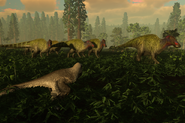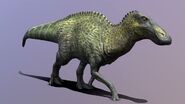"Usually known as Edmontosaurus annectens; Anatosaurus (Duck Saurian) are the quintessential "duck-billed dinosaur". These are common for such large animals, but generally favour more inland locations than the Triceratops dominated coast. Browsers not grazers, the famous, duck-like bill is used to crop leaves and shoots which are then worn down by batteries of hundreds of teeth. Hadrosaurs show some favour towards the needles of conifers, which they alone can reach to a greater extent than the other herbivores of Hell Creek."
― Saurian encyclopedia
Anatosaurus (meaning duck lizard) was a species of flat-headed or saurolophine hadrosaurid ornithopod dinosaur (a "duck-billed dinosaur") from the very end of the Cretaceous Period, in what is now North America. However, "Anatosaurus" has been established to be a junior synonym of Edmontosaurus annectens and is now an invalid name. It is currently in Saurian.
Information[]
Remains of E. annectens have been preserved in the Frenchman, Hell Creek, Laramie and Lance Formations. All of these formations are dated to the late Maastrichtian stage of the Late Cretaceous Period, representing the last two million years before the extinction of the dinosaurs (between 68 and 66 million years ago). Edmontosaurus annectens is known from numerous specimens, including at least twenty partial to complete skulls, discovered in the U.S. states of Montana, South Dakota, North Dakota, Wyoming, Colorado, Alaska and the Canadian provinces of Saskatchewan, Alberta, Yukon, Manitoba, Northwest Territories, and British Columbia showing it was wide spread and successful. It was a large animal, up to approximately 12 metres (39 ft), potentially up to 15 m (49 ft) in length, with an extremely long and low skull and a proportionally massive tail which is characteristic with most duck billed dinosaurs.
As a hadrosaurid, Edmontosaurus was a large terrestrial herbivore. Its teeth were continually replaced and packed into dental batteries that contained hundreds of teeth, only a relative handful of which were in use at any time. It used its broad beak to cut loose food, perhaps by cropping, or by closing the jaws in a clamshell-like manner over twigs and branches and then stripping off the more nutritious leaves and shoots. Because the tooth rows are deeply indented from the outside of the jaws, and because of other anatomical details, it is inferred that Edmontosaurus and most other ornithischians could have had cheek-like structures. The function of the cheeks would have been to retain food in the mouth since it would have to chew and would not swallow like other dinosaurs. However, the presence of cheeks in ornithischian dinosaurs is highly debatable, and their presence or lack thereof might have not been universal to all ornithischians. The animal's feeding range would have been from ground level to around 4 metres (13 ft) above.
Multiple specimens of Edmontosaurus annectens have been found with preserved skin impressions. Several have been well-publicized, such as the "Trachodon mummy" of the early 20th century, and the specimen nicknamed "Dakota", the latter apparently including remnant organic compounds from the skin, a hoof-like structure in the front feet, as well as what appears to be color pattern preservation, in the form of a striped pattern in the arm's joints. Because of these finds, the scalation of Edmontosaurus annectens is known for most areas of the body. Skin impressions are less well known for E. regalis, but some well-preserved examples have been studied, including one which preserves a soft tissue crest or wattle on the head. It is unknown whether such a crest was present on E. annectens, and whether it was an indicator of sexual dimorphism.
In a 2011 study, Campione and Evans recorded data from all known "edmontosaur" skulls from the Campanian and Maastrichtian and used it to plot a morphometric graph, comparing variable features of the skull with skull size. Their results showed that within both recognized Edmontosaurus species, many features previously used to classify additional species or genera were directly correlated with skull size. Campione and Evans interpreted these results as strongly suggesting that the shape of Edmontosaurus skulls changed dramatically as they grew. This has led to several apparent mistakes in classification in the past. The Campanian species Thespesius edmontoni, previously considered a synonym of E. annectens due to its small size and skull shape, is more likely a subadult specimen of the contemporary E. regalis. Similarly, the three previously recognized Maastrichtian edmontosaur species likely represent growth stages of a single species, with E. saskatchewanensis representing juveniles, A. annectens subadults, and Anatotitan copei fully mature adults. The skulls became longer and flatter as the animals grew.
The brain of Edmontosaurus has been described in several papers and abstracts through the use of endocasts of the cavity where the brain had been. E. annectens and E. regalis, as well as specimens not identified to species, have been studied in this way. The brain was not particularly large for an animal the size of Edmontosaurus. The space holding it was only about a quarter of the length of the skull, and various endocasts have been measured as displacing 374 millilitres (13 US fl oz) to 450 millilitres (15 US fl oz), which does not take into account that the brain may have occupied as little as 50% of the space of the endocast, the rest of the space being taken up by the dura mater surrounding the brain. For example, the brain of the specimen with the 374 millilitre endocast is estimated to have had a volume of 268 millilitres (9 US fl oz). The brain was an elongate structure, and as with other non-mammals, there would have been no neocortex.
In terms of behaviour Edmontosaurus have been perceived to be herding animals based largely upon the evidence of bone beds of Edmontosaurus individuals collected together, ranging from a few, to many thousands of individuals. Herding would make sense for a plant eating animal to survive, especially an animal that lived on a landscape which included predators as large as itself, particularly tyrannosaurs such as Albertosaurus and Tyrannosaurus. There is also strong evidence to suggest that Edmontosaurus were frequently targeted and eaten by the predators of the North American late Cretaceous. Tyrannosaur tooth marks from Albertosaurus are known upon Edmontosaurus regalis fossils, though these can be perceived as signs of scavenging. Teeth marks from smaller theropod dinosaurs are also known upon the jaws of Edmontosaurus, suggesting that the neck may have been the preferred vulnerable spot targeted by such predators as it would kill quickly and would be met with little struggle. The most exciting discovery showing predator-prey interaction though can be seen upon the damaged caudal vertebrae of a mounted Edmontosaurus specimen that is on display at the Denver Museum of Nature and Science. Some of the vertebrae on this specimen have been bitten into by a large predatory theropod with a bite pattern similar to what you would expect from a tyrannosaur. In addition to this the only large theropod that is known to have existed in the same formation as this individual Edmontosaurus and also to have been big enough to reach high enough to inflict such a bite is Tyrannosaurus. What is really astonishing about this individual Edmontosaurus is that after the bite was inflicted, the bone started to heal, indicating that the attack was not immediately successful in killing it, and that the individual survived for long enough for the bone to partially heal. This proves that this Edmontosaurus was alive at the time of the attack and therefore it cannot be a case of scavenging. Further study of the specimen by renowned palaeontologists Kenneth Carpenter has also revealed that the left hip also has a partially healed fracture from an injury that likely happened before the attack that resulted in the tail injury. This may mean that when this individual Edmontosaurus was attacked, it may have had a slight limp which resulted in it being targeted by a tyrannosaur which attempted to kill it.
Edmontosaurus is known to have had one of the broadest geographical distributions of all the known North American hadrosaurs, something that a 2008 study by Bell and Snively considered to have been the result of migratory behaviour. Migratory behaviour may have also been possible considering that if Edmontosaurus did live in groups, they may have had to continually move to avoid exhausting available food resources. In addition the occurrence of vast bone beds may have been caused by many Edmontosaurus drowning together as they tried to cross rivers swollen with flood water, as has been proposed for other types of dinosaur such as ceratopsians. However there are doubts as to whether Edmontosaurus were truly migratory, potentially moving many hundreds if not thousands of miles with the seasonal growth of plants, or if they instead did not roam as far. One study by Chisamy et al in 2012, revealed that hadrosaur remains recovered from what were more polar regions, were from populations that lived there all the time rather than from a migratory population. Perhaps a more general scenario would be that as with most animals, Edmontosaurus stayed where the food was, only moving on to the next horizon for food when they had to.
In Saurian[]

Male Anatosaurus walking close to a live and a dead Dakotaraptor
"Anatosaurus" is one of the most common dinosaurus in Hell Creek, and will likely be a major food source for Tyrannosaurus. It is green with darker spots and rings on the tail. Males have multicolored stripes on the head and neck, presumably for display.
Currently, Anatosaurus can be found in the game, living in herds. Males and females are found in groups, mostly in fern prairies and in forests. Ontogenetic stages are yet to be added in the game.
Dakotaraptor gameplay[]
Dakotaraptor gameplay makes it hard to take an Anatosaurus down, as they are very large and live in self-protecting herds. For defense, Anatosaurus attempt to trample the player, bite it or use their tails to whip off the attacker. In order to take one down, the player should attempt to isolate one of the Anatosaurus from its herd, then do RPR multiple times. One must be careful if it's moving close to its herd, and the player definitely does not want to be whipped by its tail and die instantly. Anatosaurus usually ignore the player as a hatchling or juvenile, but will attempt to chase the player away or attack it, as a subadult and as an adult, if the player is too close for comfort to the hadrosaur.
Triceratops gameplay[]
Anatosaurus are largely harmless to Triceratops. They may still receive trample damage however. Occasionally, a Triceratops may hurt an Anatosaurus, or vice-versa, leading to conflict, sometimes leading the rest of the herd with it. Adult Triceratops are however stronger than adult Anatosaurus and can kill one with some ease.
Behind the Scenes[]
The Saurian team chose the name "Anatosaurus" over Edmontosaurus annectens because the Hell Creek hadrosaur species arrived two million years after the last occurance of Edmontosaurus regalis in the fossil record and due to anatomical differences between the two species of Edmontosaurus, which, according to the developers, is enough to name it in a different genus.[1]
"Anatosaurus" was one option in a poll for the new playable herbivore, alongside Ankylosaurus and Denversaurus. It lost to Ankylosaurus, though many wanted it to make the playable roster. Later it has been made aware that the Anatosaurus would not make a viable playable anyway, due to their migratory nature and the fact they made their nesting grounds outside of Bone Butte, the area the game focuses on, which prevents all ontogenetic stages from being displayed in the game.
Gallery[]
Notes and references[]
- ↑ Turinetti, Nick. (June 6, 2016) Anatosaurus and the Name Game. Saurian Website. Retrieved September 7, 2016



















